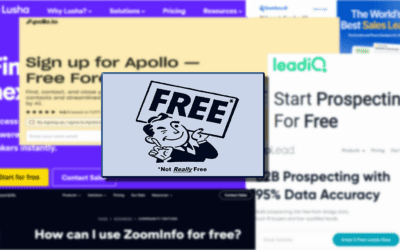4 Types of Intent Data for B2B Sales for 2024
Intent data is a popular way for companies to connect with customers that may be passively researching solutions that align with that company’s offerings. A buyer’s journey is usually a series of events over time, comparing solutions, doing research, and collecting information before reaching out to and making a decision. Because of the complexity and differences in each buyer’s journey, companies can try to shorten that sales cycle through Intent Data.
What are the different types of Intent Data?
Traffic Intent
The first type of Intent Data most companies engage with is Traffic Intent captured from a company website through analytics, tracking code, chat features or various marketing efforts. This can provide some insight for future advertising or outreach efforts, but it is often anonymous unless they fill out a form or identify themselves through a chat platform. Some companies like Kickfire can translate an IP address into a company, but usually only larger organizations with internal servers can be identified correctly.
Content Intent
Content Intent is what most intent companies provide. The process involves identifying when prospects read an article or download some type of content like a whitepaper or one-pager that shows that the person is actively researching based on the topic of the content. This can be an effective approach however there are some gaps with this process. For example, there are many business professionals who research various topics and consume content without ever having an intent to buy from those companies tied to the topic or keyword. Also, the topics you can follow are limited to very broad industries. Companies in this space include TechTarget, Gartner, and Bombora.
Review Intent
Review websites like G2Crowd, TrustRadius, and Capterra among others provide a good source for intent data based off of users making comparisons between 2 or more companies to see differences in features, customer satisfaction, price and more. This is a more effective approach to Intent data because these review websites usually require users to log in, and this effectively identifies a potential customer. There are some anonymous users that are tougher to identify, but overall it’s a much better approach than content consumption.
Growth Intent
Growth Intent involves finding companies that are within your ICP that are growing and purchasing solutions within a data provider’s platform. Growth Intent (like Lead411 provides), can show companies within a specific ICP (that you determine) that are hiring, expanding locations, receiving funding, releasing a new IPO and more. These indicators show which companies have money and need to sustain growth through addition of future solutions and services. These indicators can also fuel data from other types of Intent. For example, if you see that a company is looking at your website, or digesting content, or comparing your company on a review website, you can look up this company to find out if they are in growth mode, and reach out with a better conversation to start a business relationship. It proves that you did your own research, and have a vested interest in the events within their company.
Recent Posts
5 Ways Customer Service can Shape Your Ideal Customer Profile (ICP)
Understanding your Ideal Customer Profile (ICP) is crucial to targeting the right prospects and ensuring long-term business success. While data points like industry, company size, title and growth indicators often dominate ICP discussions, an overlooked but vital...
Free B2B Data: 6 Reason’s Why Free Data Is Not Worth It
Free B2B Data: The Costly Mistake You Can’t Afford to Make When you’re running a B2B sales operation, the idea of “free” can feel like a lifeline. Free B2B data, free tools, free trials—they’re tempting, especially when you’re managing tight budgets and aggressive...
Understanding the SLED Market – B2G for Sales
The SLED industry is vast and varied, comprising state governments, local municipalities, and educational institutions ranging from small rural schools to sprawling university systems. Unlike private sector sales, public sector procurement is often a complex web of...




